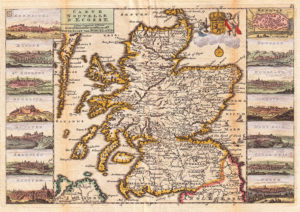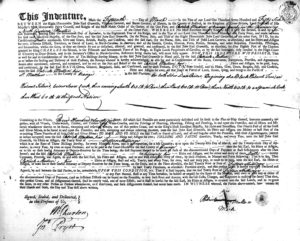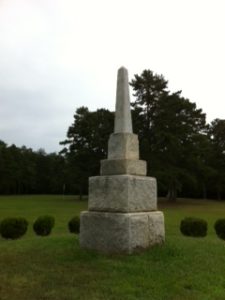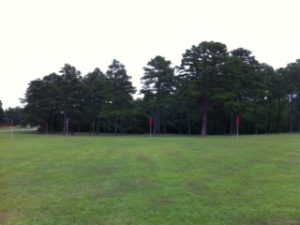
Our earliest known Mullins ancestors were Patrick Mullins and his wife Mary. Patrick was born about 1704 in Scotland [2]. This article discusses his life, his military service, and proof of his lineage to the Mullins family.
Patrick served in the British Army as a young adult [2]. In 1728, he sailed from England to Virginia [7], where received a land grant of 350 acres in Goochland County on 28 Sep 1728, for 25 shillings [2a]. We know from land deed records that he moved to Amelia County, Virginia, by 1746, and remained until at least 1754, when he purchased 41 acres on the Appomattox River in Amelia County [2a].
In 1756 Patrick and family moved just across the Virginia border to the Piedmont region of North Carolina, where he was granted 375 acres of land on the Dan River, on 15 Mar 1756, by John Cateret, Earl of Granville [2b]. The land grant is shown below. Cateret was a British nobleman who had Royal title to a 60-mile wide swath of land that comprised the northern part of the North Carolina Province. The area attracted settlers due to abundant game, rich farmland, and well-watered woods.

Patrick settled on the Dan River, in Rowan County, where the next three generations of Mullins would remain. The Dan River land purchased by Patrick in 1757 was in the future Rockingham County, just a few miles from the Lickfork Primitive Church, near present day Reidsville, where Patrick’s son Rev. Thomas Mullins would preach for 28 years.
Patrick’s son Reverend Thomas Mullins was born in Brunswick County, Virginia in 1736. On 16 Jul 1766, Patrick deeded 120 acres on the south side of the Dan to “Thomas Mullins, his son”. Several other deeds in the same year show that Patrick sold almost all of the 375 acre Granville land grant in 1766. His name shows up shortly afterwards on deeds showing that he acquired land a few miles to the east, on Hogan’s Creek and Jacob’s creek, both in the future Rockingham County. Below is proof of Patrick Mullins’s military service, and proof that he was the father of Rev. Thomas Mullins.
Evidence Of Patrick Mullins’s Qualifying Military Service for the Society of Colonial Wars
Patrick Mullins is listed on the payroll of the Rowan Co. NC militia for 1759 and 1760 [1]. His name is misspelled “Mullon” on the 1759 and 1760 militia lists, but we assume this is the same individual listed as “Patrick Mullin” on the 1759 Rowan Co. Tax List.

State Historic Park. Photos by Wells Martin III
Patrick Mullins fought as a Regulator at the Battle of Alamance (NC) on May 19, 1771 [2]. The Rev. David Caldwell was present at the Battle of Alamance. The following eyewitness account of the Battle of Alamance is quoted from Caruthers [3]:
“An old Regulator with whom I conversed last fall, told me that in the part of the army, if it might be called such, where he was, the younger part of the men were all engaged in the athletic exercises, wrestling, jumping, &c., and that he was himself engaged in wrestling with another young man, when Patrick Mullen, an old Scotchman who had been in the British service before he came to America, but was now a Regulator, came up and told them, with a look and a tone of firmness, to put themselves into some order, for they would be fired on in a very few minutes.”
Patrick is mentioned in Caruthers a second time in the following passage [4] that relates Rev. David Caldwell’s last effort to prevent the fighting at Alamance:
“About this time Dr. Caldwell rode up in front, and commenced making a speech to them [the Regulators] … but before he finished, the old Scotchman called out to him that he had better go away, or the governor’s men would fire on him in three minutes. He then rode off; but had scarcely got out of sight when the firing commenced.”

A third passage [5] relates Patrick’s unsuccessful attempt to honor a flag advancing from Tryon’s side:
“After the first fire on the part of Tryon the Regulators commenced an irregular fire from behind the trees, and had the better of the day. The other side fired regularly by platoons. – Presently a flag was seen advancing from Tryon’s side of the field. The meaning of this no body knew except an old Scotchman who had served in the army, and who called out, ‘it’s a flag, don’t fire.’ Three or four rifles were however fired; and the flag fell…”
Chronology For Patrick Mullins
The following chronology lists all occurrences of the name Patrick Mullins (with this or similar spellings) in Virginia and North Carolina records between 1695 and 1776, providing evidence that:
- Patrick Mullins is documented in Rowan County, NC, from 1756 until 1767 (specifically in the future Surry Co. area), then in Orange County from 1767 on (specifically in the future Guilford/Rockingham Co. area).
- The progression of land ownership supports the conclusion that there was only one individual named Patrick Mullins on record in Virginia and North Carolina between 1695 and 1776.
- The Patrick Mullins of Rowan County, NC, who sold land to “Thomas Mullins his son” on the 1766 deed was the same Patrick Mullins who served in the Rowan County militia in 1759 and 1760, and the same Patrick Mullins who fought at the Battle of Alamance in 1771.
The Chronology
- Scotland – Patrick Mullins was born in Scotland [6] and served in the British Army as a youth, before coming to America.
- 1728 – Patrick Mullin was documented to have immigrated to Virginia [7]. This same year, he first appeared in Virginia land records, buying 350 acres of land in Goochland Co. on September 28, 1728 for 35 Shillings [8].
Patrick must have been an adult in 1728 to purchase land in Virginia. In addition, he served in the British Army before his immigration. However, an adventurous young man might exaggerate his age. Considering these facts, it seems a safe assumption that Patrick was born before 1712, but it would be difficult to assert a much earlier year with any certitude.
- 1734 – Patrick still resided in Goochland: His land was referenced in a deed on August 1, 1734 [9].
- 1746 – Patrick next appeared in land records in Amelia Co. He purchased 390 acres on September 25, 1746 for 2 pounds [10].
- 1754 – Patrick last appeared in Virginia land records purchasing 41 acres in Amelia Co. on November 1, 1754, for 5 Shillings [11].
- 1756 – Patrick first appeared in North Carolina land records in 1756. He received a grant of 375 acres from the Earl of Granville on March 15, 1756 [12]. The certificate states that the land was in Orange County, but the location can be proven to be in Rowan County (historians have observed that the boundary between Orange Co., formed in 1752, and Rowan Co., formed in 1753, was ill-defined in the early years, and the grant to Patrick Mullins is a case in point).
Specifically, Patrick’s grant states that the northwest corner of the grant was on the Dan River, at “Walnut Island, below Snow Creek.” Walnut Island in the Dan River is 6 miles downriver from Danbury, NC, [13] in east-central Stokes County (formerly part of Rowan/Surry County).
Snow Creek enters the Dan in mile 5 (downriver from Danbury), and Walnut Island is 90 feet from the end of mile 6. The location of the grant is shown on a floodplain map of Stokes County [14]. Patrick’s grant was just downriver from Snow Creek.
Stokes County was formed from part of Surry County in 1789, which in turn was formed from part of Rowan County in 1771, proving that the Granville grant was in Rowan County, and therefore that Patrick Mullins was a resident of Rowan County beginning in 1756.
- 1757 – Patrick Mullins “of Rowan County” and “Mary his wife” sold 120 acres on the Dan River on October 15, 1757 [15]. Patrick’s name is followed by “Sergn,” suggesting he was a sergeant in the militia. This makes sense given his military experience as a youth and his age of at least 35 by 1757.
- 1759, 1760 – Patrick was listed as a member of the Rowan Co. NC militia in each of these years, and on the Rowan Co. Tax List for 1759 [16].
- 1764 – A certificate presented in the North Carolina General Assembly exempted Patrick Mullen from paying taxes in Orange County (see page F28). This was common in the colonies for men who owned land in a county in which they were not resident. In this case, the certificate is evidence that Patrick owned land in Orange, but remained a resident of Rowan in 1764.
- 1766 – Patrick Mullins sold 120 acres to “Thomas Mullins his son,” both men of Rowan County, land that specifically was part of the Granville grant [17].
- 1767 – Patrick sold more of the Granville grant: 60 acres to Moses Damon on February 2, 1767 [18] and 20 acres to William Johnson on January 9, 1767 [19]. This may have been the last of his Granville grant. He is not on record in Rowan County after 1767.
- 1767 – Patrick Mullin “of Orange County” sold 80 acres north of Hogan’s Creek on November 7, 1767 [20]. This deed and the one previous indicate that Patrick moved from Rowan to Orange County in 1767.
- 1771 – Caruthers [21] recounts Patrick Mullins’s role in the Battle of Alamance. We know that the Regulator Patrick Mullins was not a young man who is just appearing in the historical record for the first time because Caruthers refers to him as the “old Scotchman.” Further, the Regulators tended to be farmers who were being unfairly taxed, making it likely that an old Regulator would have appeared in land records before 1771.
The foregoing chronology is consistent with a single individual, Patrick Mullins, who was:
- born in Scotland;
- immigrated to Goochland Co., VA, in 1728;
- moved to Amelia Co., VA, by 1746, Rowan Co., NC, in 1756, and Orange Co., NC, in 1767;
- served in the Rowan Co. militia in 1759 and 1760;
- sold land to “Thomas Mullins his son” in 1766;
- and fought at the Battle of Alamance in 1771.
Documentation Of Date/Place Of Death
Patrick Mullins continued to appear on several land deeds in western Guilford/Rockingham County from 1778 to 1800, mostly on Jacob’s Creek (which flows between the two Dan tributaries called Hogan’s Creek. The deed of February 7, 1767 [cited above] documented that Patrick Mullins owned land on Hogan’s Creek). Patrick also appeared on the 1790 and 1800 U.S. Census: NC, Rockingham County.
There is a reference in a deed on February 26, 1800, to “… 22 ac on waters of Jacobs Cr and joins land formerly Patrick Mullins” suggesting Patrick was dead by this date [22]. Given this deed and Patrick’s (last) appearance on the 1800 census, we conclude his death date was 1800, and his place of death was Rockingham County, NC.
It is possible that our Patrick Mullins died before 1778 (perhaps even at the Battle of Alamance), and that it was a second Patrick Mullins who accounts for the individual on record in Rockingham County between 1778 and 1800. Circumstantial evidence supports the conclusion that the later Patrick Mullins on record from 1778-1800 is the same individual as the earlier Patrick Mullins, but not definitively:
- There is no evidence that the earlier Patrick Mullins had a son named Patrick in any of his deeds that survive (this does not rule out a nephew or an unrelated individual).
- Patrick Mullins is shown with no children on the 1790 and 1800 censuses and is shown “over 45” on the 1800 census, consistent with these entries being the same (elderly) individual as the earlier Patrick Mullins.
- The land that the later Patrick owned was on Jacob’s Creek, close to the holdings on Hogan’s Creek documented for the earlier Patrick Mullins.
- The consistency of the later Patrick’s land on Jacob’s Creek suggests an older man staying put, rather than a younger man who might have moved a few times, as was common for farmers in this area.
- Patrick would have been almost, or somewhat over, 90 years old in 1800. However his son, Rev. Thomas Mullins, lived to age 80, and grandson Thomas Mullins (Thomas II) lived to age 87, so such old age was not uncommon in the Mullins family.
Father Of Rev. Thomas Mullins
Patrick Mullins and Mary (last name unknown) had a son, Rev. Thomas Mullins.
Background: Patrick Mullins emigrated from Scotland in 1728 [1]. He appears on land deeds in Goochland County, VA, from 1728 through 1734, and in Amelia County, VA, from 1746 through 1754 [2]. He moved to North Carolina in 1756, when he obtained a grant of 375 acres of land on the Dan River in Rowan County, NC, from Lord John Cataret Earl of Granville [3].
The following 3 deeds establish that this Patrick Mullins had a son, Thomas, who resided in Rowan County in 1766 and Orange/Guilford County in 1773:
- In 1766 and 1767, Patrick sold his land on the Dan River to move a few miles east to Orange/Guilford Co. On an indenture dated July 17, 1766, Patrick sold to “Thomas Mullins his son,” both men of Rowan County, 120 acres of land on the Dan River, part of Patrick’s 375-acre grant from “John Earl Lord Granville” [4].
- Thomas Mullins was first documented owning land in Guilford County on an indenture dated May 11, 1772 [5]: John Mullins sold to Thomas Mullins, both men of Guilford County, 120 acres of land on the “lickfork of Hogan’s Creek.”
- On the indenture dated March 11, 1773 [6], Thomas Mullins “of the county of Guilford” sold land to William Davye in Surry County. The deed states explicitly that this was the land that Thomas bought from his father Patrick in 1766.
These 3 deeds confirm that Patrick Mullins’ son, Thomas, moved from Rowan/Surry Co. to Guilford County (adjacent to the east) between 1766 and 1772 [Surry County was formed from Rowan in 1771].
The question is whether the Thomas Mullins of these 3 deeds, son of Patrick Mullins, was Rev. Thomas Mullins of the Lick Fork Primitive Baptist Church.
Evidence
There are 3 lines of evidence that support the conclusion that the Thomas Mullins of the deeds of 1766, 1772, and 1773, was Rev. Thomas Mullins:
- The site of Patrick Mullins’s Dan River grant from the Earl of Granville is about 7 miles west of Mayodan [7]. Lick Fork Creek is about 15 miles east of Mayodan. The 1772 deed states that Thomas Mullins purchased 120 acres on the south side of Lick Fork Creek. The location of the present-day Lick Fork Primitive Baptist Church is on Lick Fork Creek Road.
All land on the south side of Lick Fork Creek is within about 6 miles of the church location [8]. Thus, the Thomas Mullins of the 1772 deed owned land within 6 miles of the church where Rev. Thomas Mullins was a minister. This is circumstantial evidence that the Thomas Mullins of the 1772 deed was in fact Rev. Thomas Mullins of the Lick Fork Primitive Baptist Church.
A sign outside of the present-day Lick Fork Primitive Baptist Church states that it was founded before 1786, based on the date of the earliest surviving church minutes. There is no way to be certain that the present-day church is in exactly the same location as it was in the 1700s, but based on the church’s name, it was likely always near Lick Fork Creek.
At this time, the Lick Fork Primitive Baptist Church has 5 parishioners, including Elder David Underwood.
- The 1773 deed (cited above) states that Thomas Mullins’ wife was Elizabeth Mullins [9]. The Lick Fork Church minutes mention Betsy Mullins several times between 1791 and 1806 [10]. The church minutes do not mention any other female Mullins, nor any other male Mullins besides Brother Thomas Mullins.
These facts comprise circumstantial evidence that Thomas Mullins of the 1773 indenture was Rev. Thomas Mullins, from the presumption that Elizabeth Mullins of the 1773 indenture was the same woman as Betsy Mullins of the Lick Fork Church minutes, namely Rev. Mullins’s first wife.
- A chronology of deeds and other documents is consistent a continuous record from 1772 through 1800 for a single Thomas Mullins residing in Guilford/Rockingham County. Further, there is no evidence of a second individual by this name in Guilford/Rockingham.
Chronology
This chronology represents all occurrences of “Thomas Mullins” in local deeds and other documents in Guilford and nearby counties (thus far uncovered):
- 1766 – Thomas Mullins of Rowan Co. purchases 120 acres from his father [11].
- 1772 – Thomas Mullins “of Guilford” purchases 120 acres on the Lick Fork Creek from John Mullins [12].
- 1773 – Thomas Mullins and wife Elizabeth “of Guilford” sell land in Rowan/Surry Co. to William Davye [13].
- 1782 – The next occurrence of Thomas Mullins in the Guilford Co. records is his grant of a Revolutionary War Pay Voucher [14] on June 27, 1782: Thomas Mullins allowed 20L 14s 8p.
- The military district for Pay Voucher #832 is “Salisbury District,” and more specifically the fifth line states that this is the “upper Board of Auditors” [15]. The two counties that comprised “upper Salisbury” were Guilford and Surry [16].
- This Revolutionary War Pay Voucher is evidence that Thomas Mullins served in the Guilford Co., NC, militia during at least some of the years of the Revolution, and is, therefore, evidence of his continuing residence in Guilford Co. during at least some of the years between 1776 and 1782.
- 1784 – In a grant dated November 8, 1784, the state of North Carolina granted to Thomas Mullins 454 acres of land on the Lick Fork of Hogan’s Creek [17].
- 1785 – In 1785, Thomas Mullins “seized” 900 acres of land on which the Mullins-Stacey Cemetery sits [18].
- We presume that this land seizure was from Loyalists; 1785 was a year of very active land seizures by Confiscation Committees in each North Carolina county.
- This cemetery record is the first mention of Thomas Mullins in Guilford/Rockingham County that can be definitively identified as the Rev. Thomas Mullins. This identification is for two reasons:
- The 1785 record states that Thomas had three brothers: David, Lemon and Cole [19]. This information evidently was taken from the will of Rev. Thomas Mullins [20], with a slight error: The executors of Rev. Mullins’s will were Brother David Lawson and Brother Cole from his church.
- Elizabeth Mullins m. Iverson Stacey [21] was the daughter of Rev. Mullins’s son, Thomas II [22]. Thus, this 1785 record ties the Thomas Mullins of this 1785 cemetery record directly to Rev. Mullins’s granddaughter Elizabeth.
- 1787 – Land purchase deed dated February 9, 1787, from Samuel and Mary Bethell to Thomas Mullen “for 50 pd 65 acres on Lickfork of Hogan’s Creek” [23].
- 1790 – Thomas Mullin(s) appears on the 1790 Rockingham census [24].
This chronology comprises a record consistent with a single individual named Thomas Mullins being the subject of each of the documents listed. Therefore, consistent with Rev. Thomas Mullins’s being the son of Patrick Mullins.
The absence of a second possible Thomas Mullins in Guilford County can be partially addressed with 3 documents:
- A reference of North Carolina wills 1665-1900 lists only 2 Thomas Mullins’ in Rockingham County for whom a record of a will exists [25].
This reference lists the will of Thomas I probated in 1817 and the will of Thomas II probated in 1859 [26]. No other Thomas Mullins is noted in Rockingham County. There is one other “Thomas Mullen” in North Carolina, will recorded in 1785, from Perquimans County [27], which is well to the east near the Atlantic.
Most wills from Colonial times do not survive, but the fact that large tracts of land were involved in the 1772 and 1784 indentures, and the 1785 land seizure, makes it more likely that the will of a second Thomas Mullins would have survived as the subject of subsequent indentures and other legal matters.
- A search on ancestry.com yields only one Thomas Mullin(s) in Rockingham County in 1790.
- A search on ancestry.com yields 2 Thomas Mullin(s) in Rockingham County in 1800: The Rev. Thomas Mullins, and his son, Thomas II.
Summary
The above comprises evidence that there was only one Thomas Mullins in Guilford/Rockingham County from 1772 to 1790, and that this Thomas Mullins was, therefore, the son of Patrick Mullins of Rowan County.
Documentation Of Patrick’s Wife, Mary
On a deed dated October 15, 1757, Patrick Mullins of Rowan County and “Mary his wife” sold land to Enoch Conly [28]. Mary’s dates and places of birth and death are unknown.
© 2013 W. Mullins
